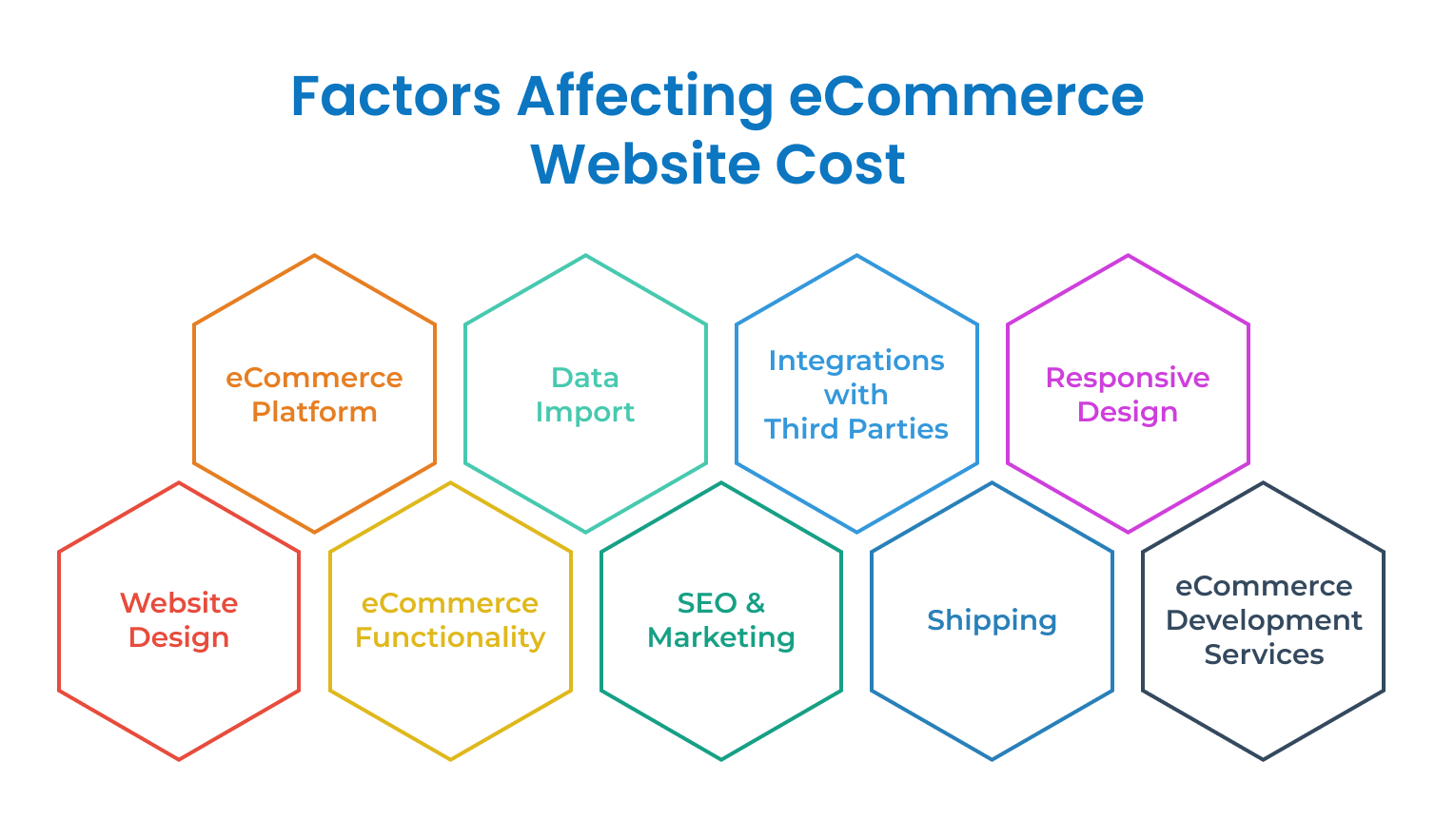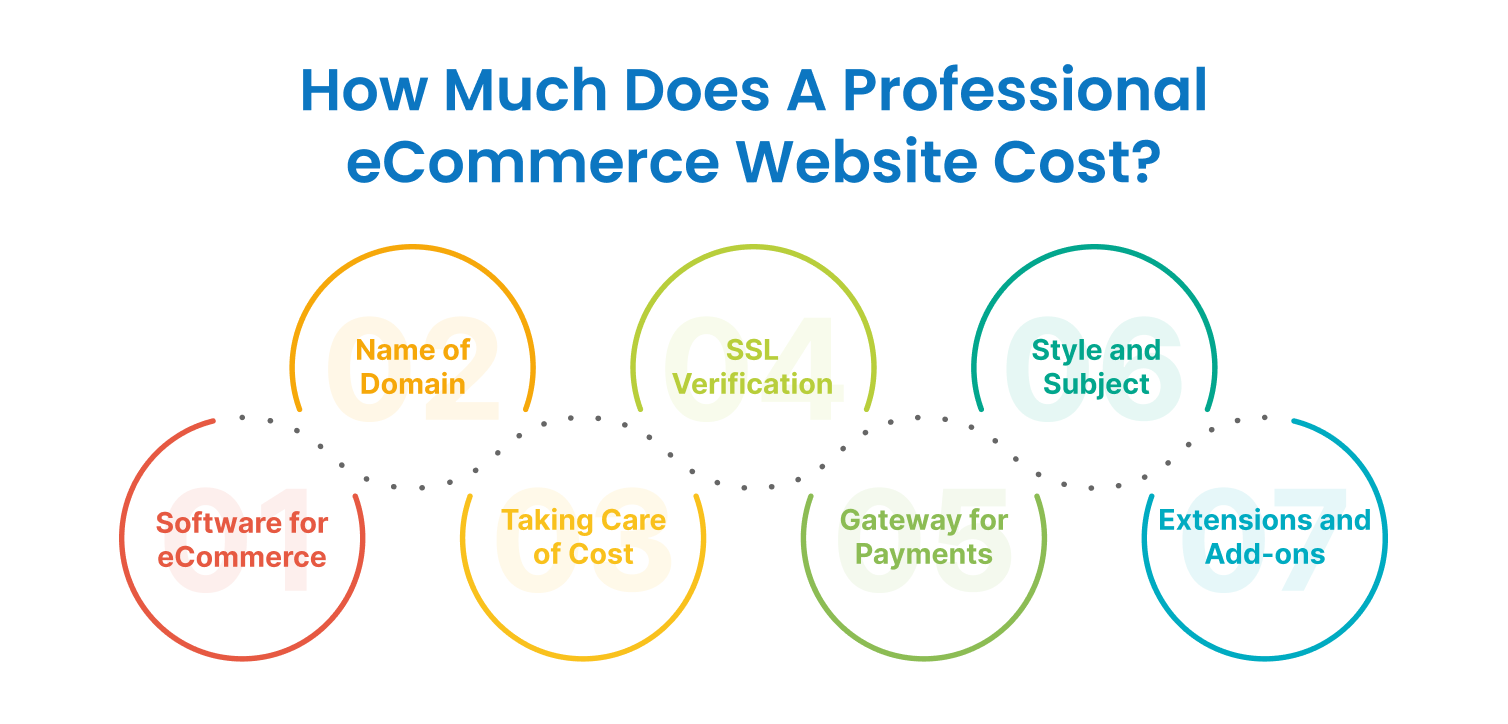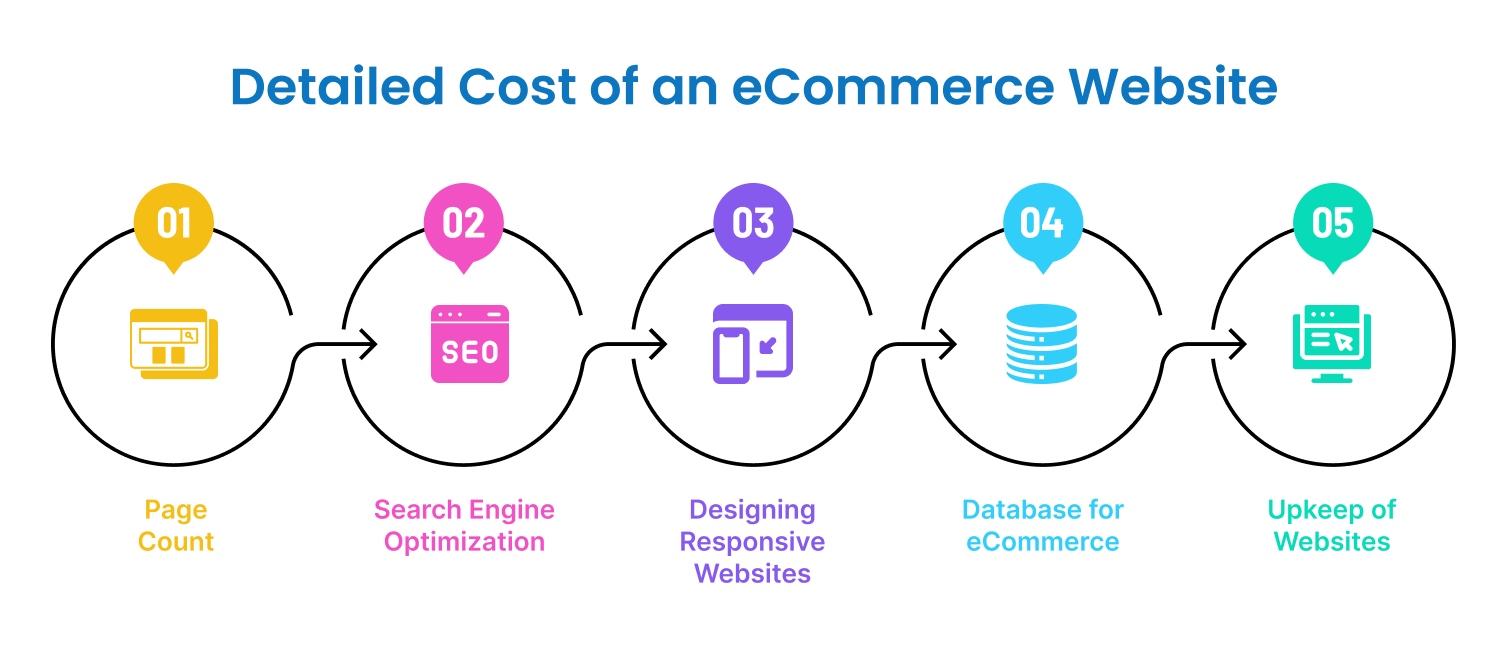
Here’s what you will learn:
Nowadays, the construction of eCommerce sites exceeds expectations when the development of high technologies is ceaselessly evolving. Businesses concurrently have always been to change to meet their customer in their demand by starting using simple online stores and going to have complex, multichannel platforms. In this blog we will see the eCommerce website development cost and its features.
Table of Contents
Evolution of eCommerce Website Development
A stunning development of technology and miniatures of good user experience sprang out of creating eCommerce websites. On these sites, previous products were exhibited, and they didn’t have any obvious interaction. However, eCommerce websites today are more interactive and user-friendly due to the ecosystem of integrated payment services, response designs, and mobility optimization.
How Businesses Can Benefit from eCommerce Websites in 2024
We will witness a plethora of opportunities for businesses with more room for growth and expansion through the eCommerce channels in 2024. Smartphones are popular nowadays; eCommerce platforms are becoming more popular as people prefer the internet to buy goods. Companies in this way can increase their consumer base and improve customer services by using eCommerce.
It also brings the global market to their platforms. eCommerce software development cost affect businesses that have in their power high-tech solutions to bring about such unique shopping experience that leads to growth in revenue as well as strengthen customer loyalty with the help of AI, AR, and other similar technologies.
Factors Affecting eCommerce Website Development Cost
Several factors influence the cost of developing an eCommerce website.
The cost of launching an e-store online may significantly differ based on several factors provided that we live in the dynamic world of eCommerce. Such factors are vital in assessing the total value of the service and the efficiency and proper functioning of the website. Let’s do a deeper analysis of each to see how it plays a role in the price setting of an eCommerce website.
Website Design
Any eCommerce endeavor must start with a strong website design since it has a direct impact on user experience and brand image. Development expenses might vary greatly depending on how complicated the layout, graphics, and user interface are. eCommerce integration solutions compared to pre-designed templates, customized designs that are suited to certain brand aesthetics are often more expensive.
Furthermore, the total cost is influenced by aspects like responsiveness, accessibility, and simplicity of navigation since they need close attention to detail and thorough testing to guarantee good performance across a range of devices and screen sizes.
eCommerce Platform
Selecting the best eCommerce platform is essential as it affects the website’s operation, scalability, and adaptability. Proprietary systems like Shopify and BigCommerce provide integrated functionality and out-of-the-box solutions but at a higher price point. In contrast, open-source platforms like Magento and WooCommerce offer customization choices and cost reductions.
The platform chosen is determined by several variables, including long-term growth goals, financial restraints, and business needs. eCommerce software development cost should include an account for continuing licensing fees, maintenance expenses, and platform updates.
eCommerce Functionality
An eCommerce website’s functionality includes a broad variety of features and functionalities, such as order fulfillment, payment processing, inventory monitoring, and product administration. Costs associated with developing advanced functionalities—like product customization, subscription services, and multilingual support—increase because they call for complex development and integration. Furthermore, eCommerce app development guarantees flawless functioning and regulatory compliance, aspects like scalability, security, and compliance with industry rules may need further expenditures.
Data Import
A crucial but sometimes disregarded part of website creation is moving current data, including order histories, customer information, and product catalogs, to the new eCommerce website development cost. The amount of data, data format compatibility, and data cleaning needs all affect how complicated a data transfer will be.
eCommerce website development company help a lot in additional costs can apply to data migration tools and services, particularly for large-scale eCommerce businesses with big data repositories.
SEO and Marketing
For an e-commerce website to get the maximum amount of sales and recognition, good digital marketing and search engine SEO are to be employed. Paid ads campaigns combined with social media marketing, content development, link building, and keyword optimization are the outcomes of money invested into paid search. Furthermore, the budget column has to be included for affiliate marketing projects, email marketing automation, and paid ads campaigns being created to generate proposals and keep long-term customers engaged.
Integrations with Third Parties
Third-party integration(s) like payment gateways, shipping companies, inventory management system(s), and CRM software improve the functionality and throughput of eCommerce marketplace development. The number of connections, however, only complicates the development process and might turn to more expense in terms of access fees like to API or continuing maintenance and support.
Shipping
Since shipping logistics have a direct influence on order fulfillment and customer happiness, they are essential to eCommerce operations. The total cost of developing an eCommerce website is influenced by several factors, including international shipping compliance, tracking features, delivery alternatives, and shipping prices. Omnichannel retail solutions expedite the shipping process and reduce shipping-related costs, integration with logistics companies and shipping carriers, as well as the installation of shipping calculators and real-time shipping quotations, need careful planning and investment.
Responsive Design
To provide a seamlessly pleasant user environment across all devices and screens, unwinding responsive design is vital considering broad consumer mobile habits and the growing phenomenon of mobile commerce. It requires extra work from the time of design to the development of the responsible website since styling, content and even the feasibility of the website should be adjusted to fit the different viewing sizes and the interaction of the user during its lifetime.
On the flip side, adaptive design improves visibility and user engagement, but it could bring overheads because optimizing the product for many platforms and devices platforms might be a costly exercise. B2B eCommerce platform development company provides effective design that can be use.
eCommerce Website Development Services
A partnership with an eCommerce development services provider that has the necessary skills is a must to ensure the scalability, reliability, and quality of the eCommerce website of your business. Developers and designers possess the required expertise and technical abilities to come up with solutions that are well-fitted and address the demands of a competing business and the needs of the general user.
Online marketplace application software even though it includes some beginning costs related to outsourcing eCommerce development services, it could be mentioned that these short-term costs are justified by the marginal gains in the long run such as a quicker time to market, and so on.
How Much Does an Enterprise eCommerce Website Development Cost?
The cost breakdown of a professional eCommerce website typically includes.
What Is the Price of An Expert eCommerce Website?
A good eCommerce website’s pricing breakdown usually includes of a quality eCommerce website must include several necessary components, each of which raises the final cost. Let’s examine the breakdown of costs usually related to creating a business-grade eCommerce website.
Software for eCommerce
The license fees or platform subscription prices are one of the main expenses involved in developing an eCommerce website. Well-known eCommerce systems with varying price options for different company requirements include Shopify, Magento, WooCommerce, and BigCommerce.
Depending on the plan selected and the size of the company, these plans may cost anything from a few dollars to several hundred dollars per month and include services like website hosting, security, and support.
Name of Domain
It turns out that the strategy of creating a trademarked, one-of-a-kind domain is the first step to effectively distinguishing your online presence and brand identity. The minimum requirement to register a domain equally depends on several factors like domain registrar and extension.
eCommerce consulting services can easily provide you the prices of premium domain names that make this need, the registration of a single domain name in a year, the average price of which costs from $10 to $50, which is much higher and sought after—all prices up to hundreds of dollars.
Taking Care of Cost
For the websites to be available to users on the Internet, web storage is necessary. The cost of hosting varies with several parameters such as bandwidth, needs for server space, uptime insurance, and additional services like backups and SSL certificates. eCommerce website development cost server plans that can accommodate multiple websites on one machine will cost approximately $10-$50 per month, while shared hosting plans cost from $5 to $30 per month.
Compared to Common Vulnerabilities and Exposures (CVE), FIRST is a much broader and more comprehensive framework that can be applied to a variety of incidents. B2B eCommerce Solution for Retails unlike shared hosting plans, dedicated hosting plans bill hundreds or thousands of dollars per month, and only serve one single website may be offered.
SSL Verification
With email, eCommerce websites may use SSL certificates which are essential in ensuring secure transactions and data encryption. Sensitive data, such as banking card numbers and personal information, are scrambled employing SSL certificates, which are the necessary prerequisite for the prevention of hackers breaking through security and other online dangers.
Now, some hosting providers include SSL certificates in their packages for free, but to have the most advanced ones that are equipped with the complicated security features you have to pay an extra $50 – $300 per year.
Gateway of Payments
Payment gateway integration into an online payment system securely and effectively will render it safe. Generally speaking, the payment gateway providers assess the transaction charges being the amount of the completed transactions and the value of the transactions processed through the gateway.
By another, you will have the opportunity that based on the payment gateway used and the number of transactions your company processes, some payment gateway providers may charge you establishment fees, monthly fees, or fees per transaction. eCommerce website development cost with every bit of digital payment involves extra costs by hand which tend to be between 1% to 3% of the amount of the transaction.
Style and Subject
Formation of an eCommerce website that will both be interactive and convenient involves using a quality template/theme and custom website design. There are many platforms out there that offer brand clients free themes or templates, but some organizations may feel that to stay ahead of their competitors and to give customers a unique experience they will have to go for premium themes or invest in custom design services.
eCommerce website development cost will, of course, vary based on the complexity of the design as well as the amount of customization needed. Off-the-shelf themes and custom design services are often priced in the $100 to $500 and $1,000 to $10,000 range, respectively.
Extensions and Add-Ons
From integration facility to social network, from reviews on products to advanced analytics, the e-commerce website may proceed and do well on the internet. Although some eCommerce platforms have in-built extensions as well as functionality, some organizations might be required to plug paid plugins or to have developers do some customization as their requirements are particularly unique.
Paying considerable amounts of $10 to $500 or even more than that are cost for most of the plugins and extensions. eCommerce implementation services usefulness and complexity of each add-on or extension determine these fees.
Detailed Cost of an eCommerce Website
Apart from the fundamental cost elements, other aspects to consider include.
Thorough evaluations of eCommerce website prices go beyond the essential elements and include important variables that have a substantial impact on creation and upkeep costs.
Page Count
The number of pages needed for an eCommerce website is strongly correlated with its complexity and size. Adding a page requires work in design, development, and content generation, which drives up the cost. Comprehensive product lists, educational blog sections, and landing sites specifically designed for campaigns or promotions might raise the overall cost.
SEO
To increase online presence and draw in organic visitors, search engine optimization (SEO) is a crucial investment. To raise search engine ranks, SEO services include keyword research, on-page optimization, content production, and link-building techniques. eCommerce website development cost amount paid upfront for SEO services may vary depending on the services rendered and the experience of the supplier; nevertheless, the long-term advantages, such as higher website traffic and conversion rates, make the investment worthwhile.
Designing Responsive Websites
Optimizing accessibility and engagement requires a smooth user experience across devices. When a website is designed with responsiveness, it may adjust its layout, content, and functionality to fit various screen sizes and resolutions, making it suitable for users who visit the site from desktop computers, laptops, tablets, and smartphones. Although using responsive design may result in greater upfront expenses, it also improves customer happiness and retention. However, it does need more time and testing throughout creation.
Database for eCommerce
Creating and maintaining a strong database is necessary to arrange transactional data, customer information, and product inventories. Personalized customer experiences, inventory management, and order processing made easy are all made possible by an effective eCommerce database. The establishment, upkeep, and data security costs of databases add to the total cost of developing a website.
Upkeep of Websites
Maintaining a website’s functionality, security, and performance over time is essential. To handle changing technological trends, security flaws, and user input, regular upgrades, security patches, and bug fixes are required. eCommerce website development cost proactive website maintenance services come with extra ongoing costs, they assist reduce the chance of downtime, security breaches, and performance difficulties.
Other Continuous Cost Factors to Consider
Businesses should plan for continuing costs in addition to the original development cost, such as
An eCommerce website has to be maintained to drive sales, improve security, cultivate consumer involvement, and sustain operations. These expenditures go beyond the original creation cost. These are the main recurring costs that companies need to think about.
Inventory Control
Minimizing stockouts, maximizing storage costs, and guaranteeing product availability all depend on efficient inventory management. Companies have to pay for storage solutions, replenishment, and inventory monitoring. Purchasing inventory management software automates demand forecasting, buy order generation, and inventory monitoring, which helps to simplify processes. Ongoing expenditures can include expenses for inventory audits, fulfillment services, and warehousing.
Safety
Protecting sensitive client data, stopping illegal access, and upholding regulatory compliance all depend heavily on cybersecurity. Strong security measures like intrusion detection systems, firewalls, encryption methods, and security audits come at a cost to businesses. Employee cybersecurity training reduces the dangers brought on by malware infections, social engineering schemes, and phishing scams. In addition, companies could spend money on cybersecurity insurance to lessen their financial damages in the case of a security breach.
Emails with Promotions
Email marketing is still a cheap way to build brand loyalty, encourage recurring business, and foster connections with customers. Email marketing software subscriptions, email template design, content production, and campaign administration are all expensive for businesses.
A/B testing, personalization, and segmentation are crucial strategies for enhancing engagement and streamlining email marketing efforts. Enterprise eCommerce solutions increase campaign efficacy, firms may also invest resources in email list acquisition, subscriber development tactics, and email deliverability monitoring.
Promotion
The term “marketing expenses” refers to a broad category of actions that are used to draw in, convert, and keep consumers. Search engine marketing (SEM), social media advertising, content marketing, influencer relationships, and affiliate marketing schemes are just a few of the marketing channels that businesses spend for.
Marketing expenditures include costs related to creative development, analytics tools, campaign optimization, and advertising platforms. Businesses may maintain long-term development and competitiveness in the ever-changing eCommerce market by investing in client acquisition methods, retention programs, and brand-building efforts.
In Summary
Businesses must see the development and upkeep of an eCommerce website development cost as an investment rather than an expenditure, even if the costs might vary greatly based on several criteria. Through careful resource allocation and feature prioritization in line with business goals, enterprises may establish a strong eCommerce presence that propels growth and profitability in the digital era.
FAQ’s
What factors affect the price of developing an eCommerce website?
A few examples of these factors are the degree of customization needed, the intricacy of the website design, the quantity of features and functionalities needed and the integration with other systems.
What is the average price for creating an eCommerce app development?
Depending on the specifications and size of the project, the price of developing an eCommerce app development might vary significantly. A more intricate and custom-built platform with extensive functionality might cost tens of thousands of dollars or more. Yet a basic eCommerce application website with minimal features can cost as little as a few thousand dollars.
Does the upkeep of an eCommerce software development come with recurring expenses?
Yes, there are continuing costs associated with development that go beyond the original investment. These include web hosting, domain registration, security precautions (PCI compliance, SSL certificates), platform upgrades, and maintenance. A budget should also be set aside for customer service, marketing, and SEO in order to guarantee the eCommerce business’s continued success.
Can I save expenses by using pre-built eCommerce platforms?
Yes, using ready-made eCommerce systems such as WooCommerce, Magento, or Shopify may assist cut down on time-to-market and development expenses. These platforms come with a variety of features, plugins, and templates that may be tailored to meet certain company requirements. Customization that goes beyond what the platform can provide, however, can still cost extra.
How can I make sure my investment in developing an eCommerce website gets the most return?
It’s essential to properly plan and priorities your needs, choose a reliable and skilled development team or agency, receive various quotations for comparison. Furthermore, set clear expectations and lines of communication at the outset of the project in order to guarantee you get the greatest return on your investment. In addition, to optimize the long-term performance of your eCommerce website, take user experience, scalability, and performance into account.





